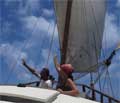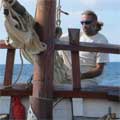 |
| Grayhound entering Falmouth
|
Are there sailors with so little romance in their soul that they wouldn't thrill at the chance to race on classic yachts of the past? Certainly not this sailor who signed on to Grayhound for the Antigua Classic Yacht Regatta. Grayhound was built two years ago on plans of a ship of the 18th century which served as both Privateer and Revenuer. Add in the shouts of "Two, Six, HEAVE!" and the echo of cannon fire rebounding off the stone walls of Nelson's Dockyard as an intoxicant. Top off with four days of racing through lively seas. This heady brew made it easy to imagine we were chasing down American smugglers in 1776.
 |
| Grayhound at the Dock
|
 |
| Marcus and Freya of Grayhound |
I met Marcus and Freya walking the docks before the Regatta. They were letting out the anchor chain to retrieve their spare cannon from underneath the chain in their walk-in chain locker. Yes. Their spare cannon. It was being donated to "Old Bob" a gaffer and worthy foe) but it left them with the anchor and chain lying on the bottom. There is nothing aboard Grayhound so anachronistic as an electric windlass to pull it up again. They don't even tolerate an outboard engine but row their gear and guests around in gigs. The crew was already worn out from hand hoisting the pile they had already retrieved. I gallantly offered to try my hand. This impressed them with both my stupidity and determination. I got a berth.
 |
| Spray
|
 |
| The permanent crew of Grayhound in the gig |
click for the next column > |
 |
| Marcus unfurls the mizzen
|
This remarkable couple built the boat and now charter her. They started by cutting the trees, making over 9000 wooden nails and finished with a new bottom and paint job just before the regatta. The web site is great and if you have ever enjoyed a Patrick O'Brian novel, you will love the story of the boat and her remarkable owners. The lugger rig is a transition between square rigged ships and the modern fore and aft sails. It has the giant telephone poles swaying overhead like a square rigger but none on the lower edge of the sail to bang you on the head. These logs must be hoisted aloft by block and tackle with shouts of "Two, six, HEAVE" One or two people pull on the inner ropes of the tackle and the fall is lead around a belaying pin and as many people as are available pull in the slack. The rhythmic cry insures that all are pulling effectively at the right moment. It's like dancing only more sweaty.
 |
| Two, six, HEAVE! |
 |
| Ready portside! |
After a few dances like that, the group starts to feel like a team. After a few races, you are a Grayhound. Our strong race was the aptly named "Cannonball". A race straight out from Falmouth harbor on a reach, back to the start and then repeated. Grayhound does not point as high nor turn as fast as the more modern designs but in a straight ahead horse race in big seas she was definitely best in her class. She is also much quieter and has a wonderful motion in big seas. I specialized in releasing the working sheet. This involves taking the sheet from the belaying pin holding it against the rack with just one turn on the pin. When the sail starts to come over, the sheet is released and the block starts to rattle and bang. I steady the wooden block and iron hook while a second hand overhauls the tackle to lengthen the distance between the two sheeting blocks. When it is long enough to reach the forestay, I unhook the block from the deck and run forward with the block and tackle to hook it at the foremast where it is sorted and made ready for use on the next tack. Sounds like an easy job but you must take into account the heaving deck, spray and my natural desire to stay on board and not get clobbered by a block or burned by a rope. Finding yourself forward during the tack, it is natural and relatively easy to take up the sheet on the forward jib before the backed jib is released. This keeps me out of the line of fire while a writhing mass of humanity is trying to tame the tackle on the main sheet and actually get it hardened up.
Did I mention that this is big fun? Plus, I won't need to go to the gym this week.
|